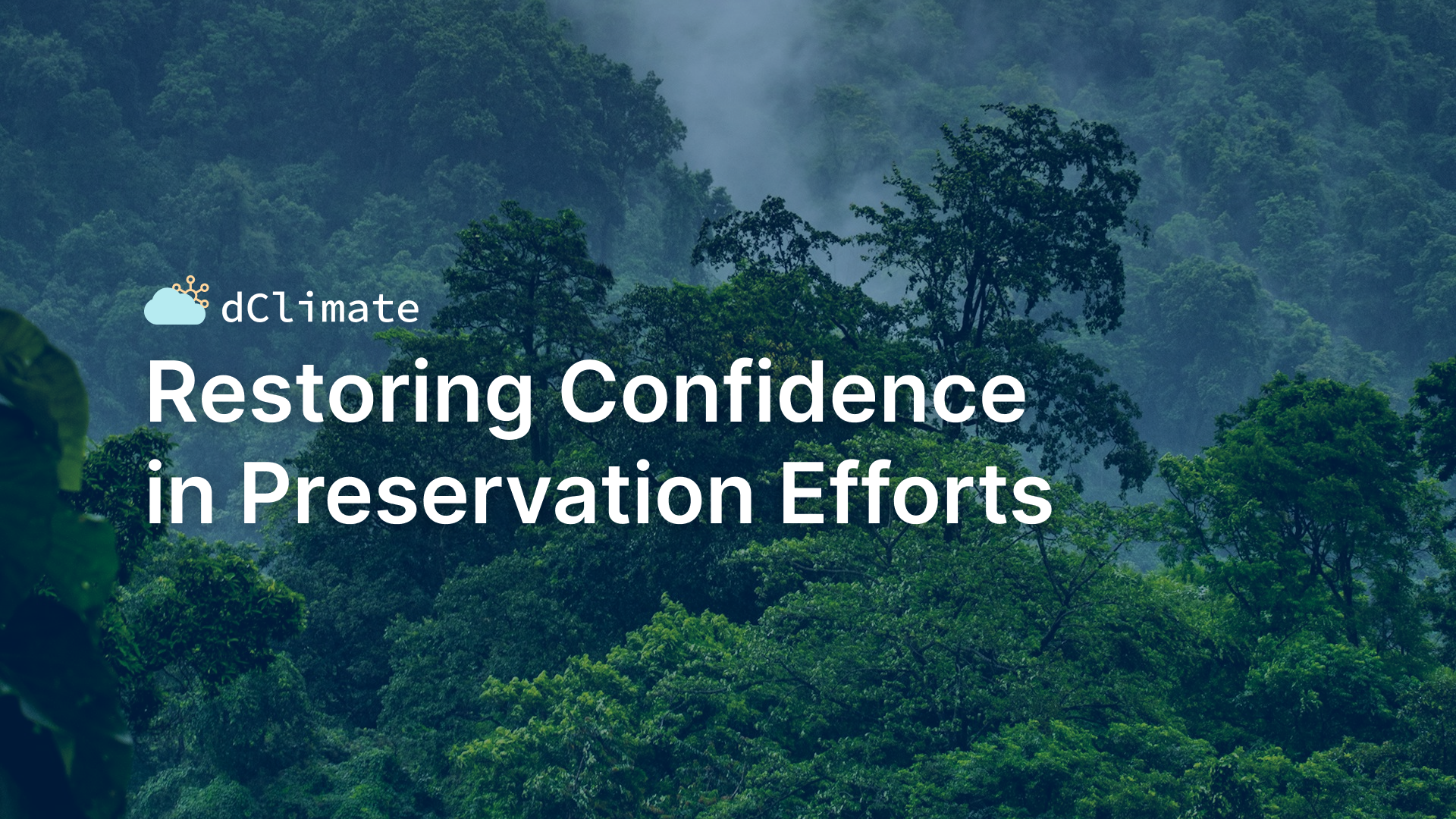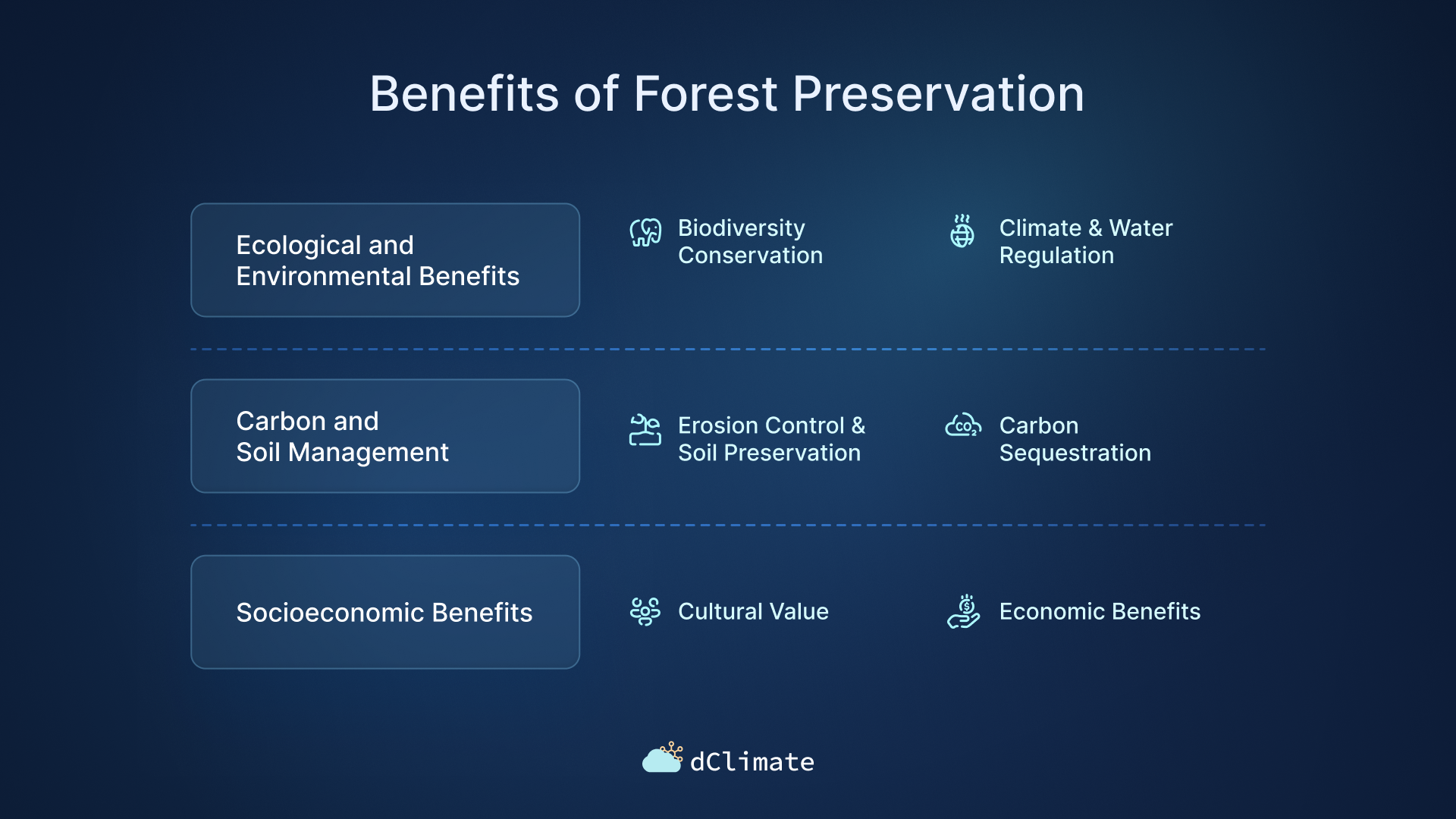Restoring Confidence in Forest Preservation Efforts

Forests play a vital role in our planet's health, acting as carbon sinks, biodiversity havens, and natural and financial resources for local communities. Voluntary carbon offset initiatives, particularly forest preservation projects and other reduced emissions from degradation and deforestation (REDD+) initiatives, are crucial tools in the fight for net-zero emissions.
In the world of voluntary carbon offsets, forest preservation projects are initiatives aimed at maintaining and protecting forest ecosystems from deforestation or degradation, often from illegal logging or from slash-and-burn. These projects implement safeguard measures to mitigate these threats ensuring the sustainability of forests for ecological balance, carbon sequestration (or avoided carbon emissions), offering several co-benefits such as improving indigenous peoples’ and local communities’ livelihoods, and the preservation of natural habitats for wildlife.

Despite the expected positive end-goal, i.e. stopping deforestation and all its direct and indirect negative consequences, forest preservation initiatives can be flawed when not implemented properly or consistently, with recent criticisms casting doubts on their effectiveness.
Challenges Facing Forest Preservation Efforts
As the saying goes, good intentions alone don't pave the road to success. This rings especially true when it comes to tackling deforestation, the world's third-largest emitter (trailing only behind China and the US). Despite the critical role forests play in mitigating climate change and supporting biodiversity, efforts to curb deforestation face a complex web of challenges:
- Negative Publicity: Forest preservation projects have recently come under fire, with some high-profile critiques, like a January 2023 Guardian article, questioning their effectiveness in meeting carbon reduction targets. Additionally, recent government actions revoking concessions due to perceived shortcomings can paint an unfair picture of dedicated conservation efforts. These negative narratives can discourage investment and public support, hindering progress.
- Complexity of Implementation: Successfully implementing forest preservation initiatives requires navigating intricate details. Identifying at-risk areas, obtaining the free, prior, and informed consent (FPIC) of Indigenous Peoples, and establishing robust monitoring systems are just some of the hurdles that can slow down project development.
- Competing Interests: Forests are often seen as sources of economic gain, with logging and resource extraction offering short-term benefits. Balancing these interests with long-term environmental goals requires strong governance, clear land-use policies, and economic incentives that reward conservation efforts.
- Lack of Funding: Forest preservation projects often require significant upfront investment in infrastructure, monitoring, and community engagement. Securing long-term funding to ensure project sustainability can be a challenge, especially in developing countries with limited resources.
- Monitoring and Verification: Accurately measuring the carbon sequestration impact of these projects is crucial. However, limitations in monitoring technologies and challenges in data collection can make verification difficult, leading to skepticism about the true effectiveness of some initiatives.
Forests, a Safe Haven
Forests offer a multitude of benefits, making them vital safe havens for both natural ecosystems and the communities that rely on them. This is how forest preservation initiatives differentiate themselves, with forests representing a safe haven by serving several crucial functions including:
- Biodiversity Conservation: Forests are home to a vast array of species, many of which are endemic and cannot be found anywhere else. This diversity is crucial for ecological stability and the functioning of global natural systems.
- Carbon Sequestration: Tropical forests are significant carbon sinks, absorbing carbon dioxide from the atmosphere and storing it in their biomass and soil. For example, the Congo Basin This helps mitigate the impacts of climate change by reducing the amount of CO2 in the atmosphere.
- Water Regulation: Forests play a critical role in water cycles and rainfall patterns. They help regulate water flow, filter water, and maintain the water quality in rivers and streams, benefiting both wildlife and human populations.
- Cultural Value: Many communities, including indigenous peoples, depend on forests for their cultural, spiritual, and physical sustenance. Forests are often integral to cultural identities and traditions.
- Economic Benefits: Beyond timber, forests provide non-timber products such as fruits, nuts, medicines, and other resources that support local economies. Additionally, ecotourism often relies on well-preserved forest ecosystems.
- Climate Regulation: By influencing meteorological systems, forests help regulate the Earth’s climate. Areas covered by forests, especially tropical ones, tend to have cooler temperatures and more precipitation than areas without tree cover.
- Erosion Control and Soil Preservation: The root systems of forest trees help stabilize soil and prevent erosion. Forests also contribute to soil fertility through the decomposition of organic material.

The Devil is in the Details
As critical component, implementing safeguard measures to prevent deforestation and other causes of forest degradation is a complex and lengthy process that includes:
- Identifying an area, a jurisdiction or a country that has been affected by deforestation
- Determining and assessing that without tangible safeguard measures, observed deforestation will continue going forward, resulting in carbon emissions
- Obtaining free, prior, and informed consent (FPIC) from indigenous peoples, one of the most critical aspects of forest conservation initiatives.
- Analyzing and selecting the adequate carbon methodology to calculate the baseline (i.e. the total carbon emissions in a business as usual scenario).
- Clearly defined project activities that will take place in the area at risk of deforestation such as replanting native species, enforcing anti-logging laws, and enhancing local community engagement.
- Getting the adequate level of funding to offer alternative solutions to deforestation drivers.
While proper project implementation is paramount, the success and longevity of a forest preservation initiative also depends on adhering to local laws and regulations. Securing the proper approvals from local authorities to convert a legal logging concession to a conservation concession is as adequate as the project itself: compliance with local laws and regulations, and collaborating with local authorities and host countries, is the foundation of forest preservation initiatives as it guarantees all stakeholders a transparent legal framework to operate and continue to benefit from the project’s monetizing schemes, i.e. carbon credits.
Without comprehensive planning, robust monitoring, and strict enforcement, these initiatives may fail to achieve their objectives and data integrity. Inadequate implementation can lead to loopholes and enforcement gaps that allow harmful activities to continue, undermining the effectiveness of the safeguard measures and ultimately jeopardizing the health and longevity of the forests they aim to protect.
The Path to Redemption: Strategies for Success
Forest preservation initiatives have been subject to scrutiny regarding their effectiveness in achieving on-the-ground conservation results. This has underscored the urgent need to enhance the integrity, transparency, and effectiveness of these initiatives. As global scrutiny and awareness grow, it becomes increasingly critical to refine and fortify forest preservation strategies. The essential challenge is to transition from good intentions to executing well-planned and thoroughly monitored projects that achieve tangible, measurable results.
Restoring confidence in forest preservation requires improved transparency and effectiveness. Key strategies may include:
- Integrating advanced technologies like digital Monitoring, Reporting, and Verification (dMRV) systems for accurate real-time data on project activities, forest health, and carbon storage.
- Strengthening local involvement through FPIC processes, ensuring projects are not only ecologically sustainable but also socially equitable.
- Establishing robust legal and regulatory frameworks that support long-term sustainability, including converting legal logging concessions to conservation concessions where necessary according to local laws and regulations, and ensuring that all activities comply with both local and international environmental standards, highlighting the need to closely work and collaborate with local authorities and national governments.
- Embracing continuous improvement and adaptation based on experience to address emerging challenges and leverage new opportunities.

Building on Past Success for Future Positive Outcomes
Climate change is occurring rapidly, underscoring the urgency to embrace all positive efforts and contributions. This includes corporations sourcing supplies locally, individuals adopting eco-friendly habits, and carbon projects aimed at reducing, avoiding, or removing CO2 from the atmosphere. Every contribution, big or small, is crucial in the collective fight against climate change.
Forest preservation is also a crucial part of the solution. Forests act as natural carbon sinks and provide habitats for wildlife, as well as support local communities who depend on both the ecological and economic benefits these forests offer.
As we grasp its importance, the success of forest preservation can be structured around three main pillars:
- Conducting thorough due diligence from all stakeholders and in particular from project developers and buyers, ensuring compliance with local laws and regulations, as well as leveraging on new technologies available such as digital MRV for higher data integrity
- Engaging early with local communities directly involved in the affected areas
- Learning from and applying lessons from successful projects
🌐 Check out our website, products, and blog
💽 Explore 40+ TB of free climate data via our data marketplace and API
📰 Sign up for our bi-weekly newsletter
🥳 Join the community: Twitter | LinkedIn | Discord | Telegram | YouTube

